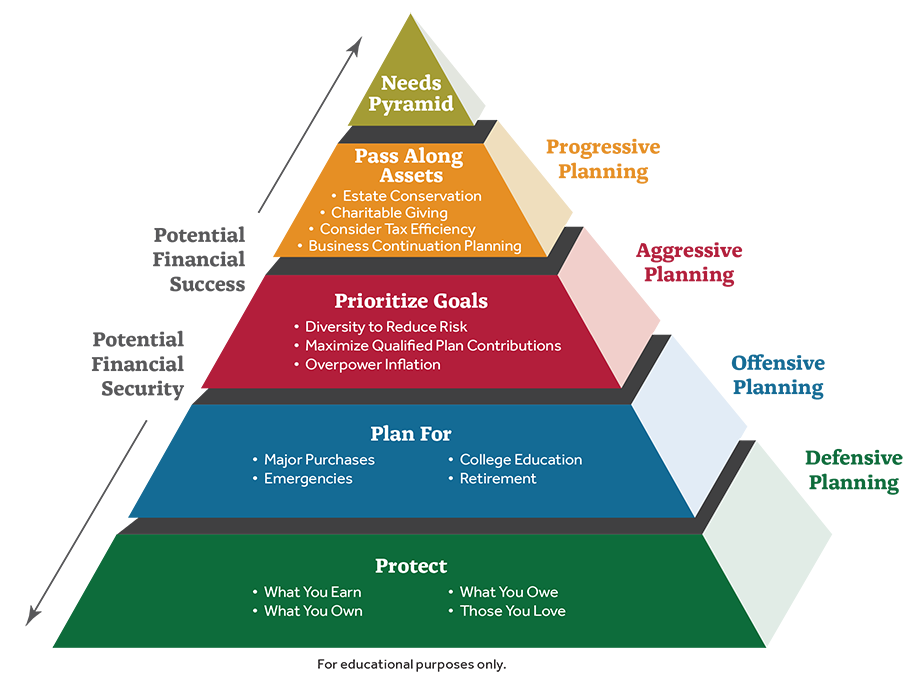On December 20, 2019, the Setting Every Community Up for Retirement Enhancement Act of 2019 (the “SECURE Act”) was signed into law as part of the government’s Further Consolidated Appropriations Act of 2020. As the law’s name implies, the SECURE Act sets forth reforms to existing rules that impact retirement plans. In a partial summary, the SECURE Act promulgates the following changes to retirement plans (particularly IRAs) as follows:
– RMDs start age increased to 72 – The age at which required minimum distributions (“RMDs”) begin changed from 70½ to 72;
– No Age Limit on IRA Contributions – Contributions to traditional IRAs can now occur after the age of 70½ to match the unlimited age limit on ROTH contributions;
– Qualified Charitable Contributions (“QCD”) are offset by post-70½ Tax-Deductible IRA contributions – Without getting into the minutiae of calculations, QCDs are allowed to be made at 70 ½ instead of 72 with one caveat – the contributions no longer avoid tax recognition to the extent of cumulative post-70½ made by the taxpayer; and
– Death of the “Stretch IRA” – Prior to the SECURE Act, IRA beneficiaries were allowed, if they chose, to “stretch” RMDs from inherited IRAs over their respective lifetimes. Under the new rules per the SECURE Act, with certain exceptions, the stretch provision is now replaced with a 10-year window for completely distributing the contents of the account.
(Note: There are many more provisions of the SECURE Act that reform retirement plans and the way that they are governed and operated. For the purposes of this article, we are focusing on the provisions of the law that have significant estate planning implications. Please consult the law at https://www.congress.gov/bill/116th-congress/house-bill/1994 for more information.)
With the changes to the stretch provisions for traditional IRAs, a valued strategy that many families relied upon as part of their estate plans was essentially erased with the stroke of President Trump’s pen. Having the rug pulled out from under them seems to be apropo in this instance.
In light of the law change, many clients are now wondering what actions should be taken to ensure that the estate plans that they developed prior to the SECURE Act, are still effective. With a focus on Inherited IRAs and the dissolution of the stretch provision, we focus on the following strategies as potential estate planning strategies for revising their estate plans in the wake of the SECURE Act:
- Accelerating ROTH conversions and utilizing a testamentary trust to create your own inherited “stretch” IRA;
- Make testamentary transfers to a charitable remainder trust (“CRT”);
- Utilize Multi-beneficiary Trusts;
- Utilizing Life Insurance as an alternative to planning for passing down an IRA; and
- Do nothing and revise your estate plan within the framework of the new IRA rules.
The “Death of the Stretch” – A Brief Summary
Pre-SECURE Act
IRA owners are allowed to name beneficiaries for their accounts. This can be anyone – a spouse (or ex-spouse), children, parents, siblings, grandparents, friends, etc. IRA owners can also name entities as beneficiaries to their accounts too, such as charitable organizations, alma maters, houses of worship, etc. Lastly, IRA owners can name entities they create, such as a trust for the benefit of a loved one, like children or siblings. Upon death, the beneficiary has the following options available when deciding what to do with the inheritance:
– Rename the IRA as their own (this option is only available to spouses)
– Take a lump-sum distribution
– Empty the account contents within 5 yrs of the year of death
– Open a new IRA account titled in both the name of the deceased IRA owner and the beneficiary (an “Inherited IRA”) and defer taking distributions by only taking RMDs based on the life expectancy of the aforementioned beneficiary (assuming that the beneficiary is younger than the deceased IRA owner, otherwise the RMDs would be based on the deceased IRA owner). This is referred to as “stretching the IRA”.
Effects of the SECURE Act
The SECURE act changed the IRA rules by allowing the same options for taking ownership of an Inherited IRA, with the exception that:
– The timeline for emptying accounts is now 10 years instead of 5 (the “10-year rule”); and
– With respect to stretching the IRA, only certain “eligible designated beneficiaries” are allowed to stretch payments over their respective lives, which include:
Spouses
Minor Children (only until such minor reaches the age of majority, after which such minor children become “Designated Beneficiaries”, as defined below)
Beneficiaries that are not more than 10 years younger than the deceased
Disabled Persons (per Code Section 72(m)(7)
Chronically Ill Persons (per Code Section 7702B(c)(2)
Certain Trusts for the benefit of Eligible Designated Beneficiaries
– “Designated Beneficiaries” cannot stretch the IRA and must adhere to the 10-year rule:
Non-Spouse Beneficiaries
Certain Trusts established for the benefit of Designated Beneficiaries
Prior to the SECURE Act, many estate plans could simply rely on the IRA stretch provision as a means to allow such assets to grow while minimizing the tax impacts of the inheritance. In addition, certain vehicles such as conduit trusts were instrumental in bequeathing assets while establishing a spendthrift to help protect beneficiaries preserve the windfalls that they inherited.
With the rule changes, primarily with the modification of IRA stretch rules, clients are now concerned about the efficacy of their previously established plans, and need education, guidance, and assistance in making sure their plans are adjusted accordingly. In addition, with a strong government mandate to raise income with a view towards taxing the projected massive transfer of wealth (estimated at $68 trillion over the next 25-30 years), smart estate planning will be key to ensure that future generations don’t lose significant wealth to potential higher tax bills.
Estate Planning Strategies
Accelerating ROTH conversions
One strategy that can be utilized that can be utilized to mitigate the adverse effects of SECURE Act Inherited IRA changes is to begin converting such traditional IRA holdings into a ROTH IRA and bequeath it outright, or name an accumulation testamentary trust as the beneficiary of the ROTH (for the benefit of the Designated Beneficiary), and through such trust, dictate tax-free distributions per the deceased owner’s wishes. The IRA owner can use the IRS life expectancy tables to create their own stretch IRA for the trust beneficiary (or beneficiaries, if applicable).
Charitable Remainder Trusts (CRT)
Another strategy for consideration involves the tax free, lump-sum distribution of Inherited IRA into an irrevocable CRT that names Designated Beneficiaries as income beneficiaries and a charitable organization as the remainder beneficiary. Conceptually, the CRT will make distributions to the beneficiaries of an IRA for up to 20 years (or the life of the beneficiary, whichever is shorter) with the remainder going to the charity named as the remainderman. There are complexities in structuring the CRT and maintaining its IRS compliance (i.e., the 10% remainder test) as well as potential drawbacks such as (1) distributions being limited to income (principal distributions not permitted) and (2) the disinheritance of successor beneficiaries due to the mandatory payment of the trust assets to the charity upon the death of the beneficiary.
Mutli-beneficiary Trusts
Multi-beneficiary trusts can be utilized to allow Designated Beneficiaries potentially benefit from Inherited IRAs bequeathed to both them and am Eligible Designated Beneficiary, such as a Disabled or Chronically Ill Person. The structures could be in the form of (a) a bifurcated trust, where the conduit trust (and stretch portion) pays out to the Eligible Designated Beneficiary, and the accumulation trust pays out to the Designated Beneficiary under the 10-yr rule, or (b) a sequential trust, where payments are made first to the Eligible Designated Beneficiary under the stretch provisions, and then to the Designated Beneficiary under the 10-yr rule upon the death of the first beneficiary. For example, let’s say Michael is a Chronically Ill 50 year old with a life expectancy of 15 years. His sister, Janet is 45 and is in good health. Both Michael and Janet inherit their father’s IRA of $1 million. As Michael meets the definition of an Eligible Designated Beneficiary, the IRA can name the multi-beneficiary trust for the benefit of Michael as the beneficiary and pay funds out under the stretch provision. Janet, the Designated Beneficiary can be named as a successor beneficiary to the trust, and upon Michael’s death receive payments under the 10-yr rule.
Life Insurance
Generally, life insurance can be used to act as an hedge against the adverse effects of the SECURE Act. By taking distributions and using part of those proceeds to pay life insurance premiums on permanent life insurance (which can be housed in an irrevocable life insurance trust, or “ILIT”) with a face amount that covers at a minimum the account size set aside for bequeathment, the IRA owner can not only gain peace of mind with the fact that the asset won’t fluctuate in value, he or she will also be pleased that such an asset is being passed on to heirs without the burden of taxes.
Keeping the Status Quo
In some situations, things might be just fine with the new rules in place. The 10 yr rule might work as an alternative to the stretch provision of the IRA, and certain alternative planning may work for clients. This due to the fact that (a) many IRA beneficiaries do not stretch their inherited funds, (b) for those that do stretch their IRAs, many exhaust their accounts within 10 years anyway, and (c) given, the size of the account, taxes, and expenses of certain strategies, the status quo is considered to be the path of least resistance.
Regardless of the strategy chosen, it makes sense to sit down with competent, licensed, and credentialed professionals to ensure that your plan contemplates all relevant variables to ensure that the strategy makes sense in light of the client’s financial goals, wishes, and financial situation.


